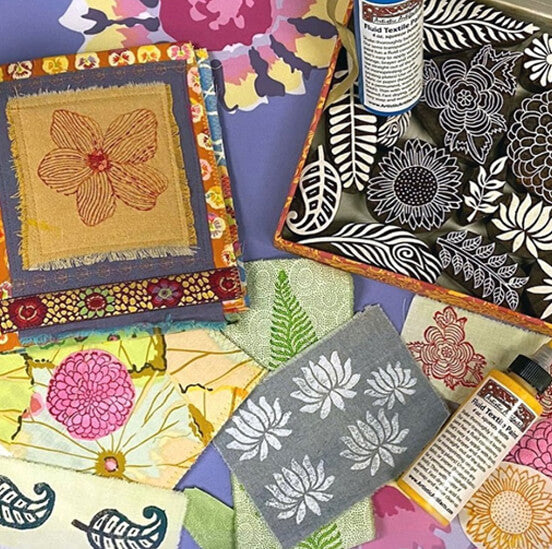Show and Tell with Artistic Artifacts
One of the greatest benefits of what we do at Artistic Artifacts is being the recipient of Show and Tell sessions, whether in the shop or via email! Here is our latest, received from Margret Lehnert, who lives in Venice, Florida:
Hi Judy, finally got the Australian Quilt done and wanted to send you pictures of it. You wanted to see the end result. I also refinished all my pillowcases to match the quilt. It all goes well with the leather sofa and chairs. The quilt pattern is the simple "Yellow Brick Road" Pattern, which has been around for a while. Also used bamboo batting to make it nice and soft. Love the fabrics and have enough left to make a table runner!

Above, Yellow Brick Road with Australian Fabrics by Margret Lehnert.

Yellow Brick Road with Australian fabrics quilt and pillows on leather sofa
Also, we held a fun tag class on Saturday, June 14, Words of Wisdom: a Little Book of Design Inspiration with Diane Herbort. Ann Douglas was one of the students enjoying the day. Her beautiful granddaugher was unable to join us in the class, but afterwards enjoyed a craft day with Grandma!

On June 12 we hosted our monthly “How Do I Use This?” product demonstration and hands-on play. The subject this month was using deColourant and DeColourant Plus. These products work on dyed natural fabrics, such as cotton, rayon, or linen, as well as on many papers.

We stamped and applied deColourant (removes color) and deColourant Plus (no longer available, it removed color while adding a new color pigment) on fabric swatches and on handmade paper. (Above, Decolourant wooden block printed on handmade black paper.) I have used DeColorant on fabric many times, but I had never tried it on handmade paper.

As you will see we all made use of my favorite tools, wooden printing blocks to create surface designs! So I'll begin with a quick review of how to print using wooden blocks:
Pour a small amount of deColourant onto a plate or palette, then use a sponge apply it to the wooden printing block. Place your paper or fabric on a foam printing mat, then press the wooden printing block firmly onto the surface to transfer the deColourant.

I did find that the sponge did not work as well with deColourant as it does with Fabric Paint. We tried a fan brush during our class and got better results. Above, results of deColourant on fabric.
After the deColourant is dry, iron with a hot (cotton setting) steam iron to active the discharge. Heat is necessary to activate the deColourant, and the more heat, the more color is removed, so ironing, with steam, seems to give the best results. (The manufacturer notes that you can use a heat gun, or even lay your fabric or paper out in the sun.)

Results of deColourant on Handmade Paper
Using deColourant, you will find that some dye colors discharge to lighter versions of the original color (like a pale pink from red), some turn to a different color entirely (black fabric and paper is known for this surprise; you can see it discharge to white, or to light oranges, greens and more), and some don’t discharge much at all. You have to test and experiment!
One of the great features of these products is that they don’t change your fabric or papers in any way: the “hand” of your surface remains unchanged.

Above, tags made using my stamped handmade paper. deColourant works exclusively on the color dyes that are in the fabric and paper, removing in an easy, one-step process. As I had noted, I hadn’t previously tried deColourant on paper, so the results of that were fun to see!
Join us for next month’s “How Do I Use This?” session on Thursday, July 10, 6:30 - 8:30 pm — we will be experimenting with Gelatos!
Some additional photographic inspiration from our session:

One side of the Table

Theresa assembling her tags.

Judy Albert ironing -- turning stamping into magic.

Bubble Wrap will go down in History as the best stamp ever!

Barb's Tags







Leave a comment